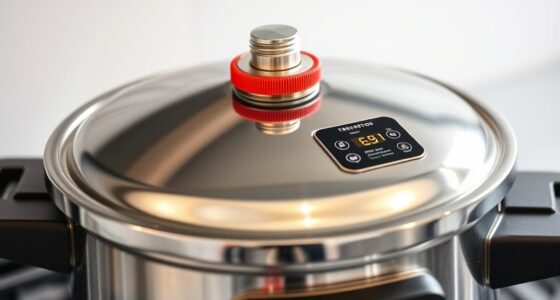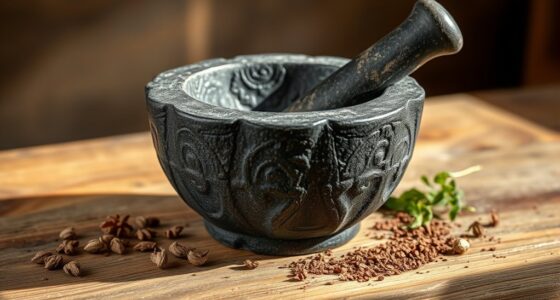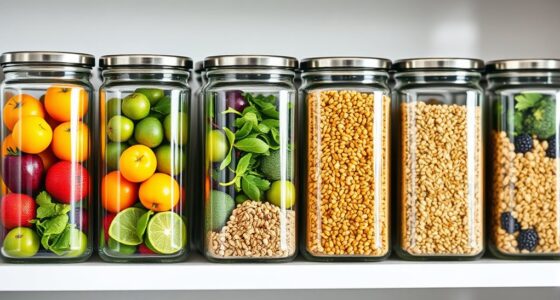Most people use their vegetable peelers incorrectly by applying excessive pressure and moving in only one direction, which slows down the process and increases safety risks. Modern peelers, especially double-edged and multi-directional designs, are meant to be used with controlled, back-and-forth motions in both directions for faster, safer, and more even peeling. If you stick to traditional techniques, you’re missing out on improved efficiency—keep going to discover how proper technique makes all the difference.
Key Takeaways
- Traditional peelers often only support single-direction peeling, missing out on faster, more efficient dual-direction techniques.
- Wobbling blades are intentional design features that improve peeling smoothness, not signs of defect or damage.
- Applying excessive downward pressure can hinder progress and increase safety risks; controlled, gentle strokes are more effective.
- Using peelers with blades parallel to the handle enables multi-directional peeling, boosting speed and reducing effort.
- Proper technique, including stable vegetables and controlled movements, is key to safer, quicker, and more even peeling.
The Hidden Design of Your Peeler and Its Purpose
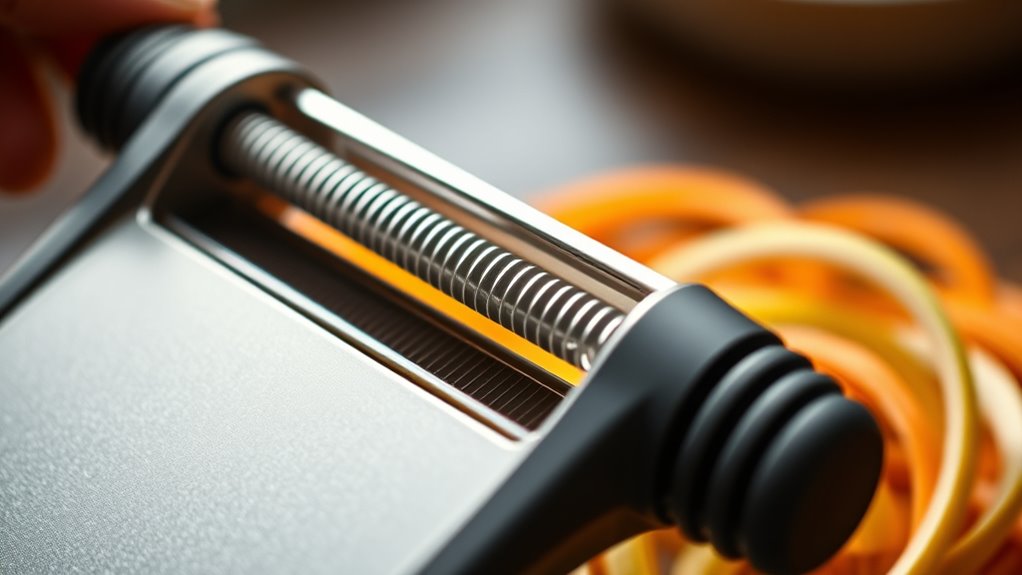
Many vegetable peelers are designed with a flexible, double-edged blade that moves back and forth. This flexible design isn’t a flaw; it’s intentional, allowing the peeler to adapt to uneven surfaces and contours of your produce. The blade’s wobbliness helps you peel more smoothly and efficiently, especially on irregular shapes. Most vegetable peelers have blades set parallel to the handle, which makes rocking the blade easier and more effective. Different types of peelers are tailored for specific tasks, like peeling thin strips or citrus, thanks to their blade orientation and flexibility. Knowing why your vegetable peeler is built this way helps you use it properly, reducing frustration and extending its lifespan. Embracing this design reveals its true purpose, making peeling easier and faster. Additionally, understanding the design features of your peeler can help you select the best type for various kitchen tasks, ensuring optimal performance based on the blade orientation and flexibility.
Common Mistakes in Using Vegetable Peelers
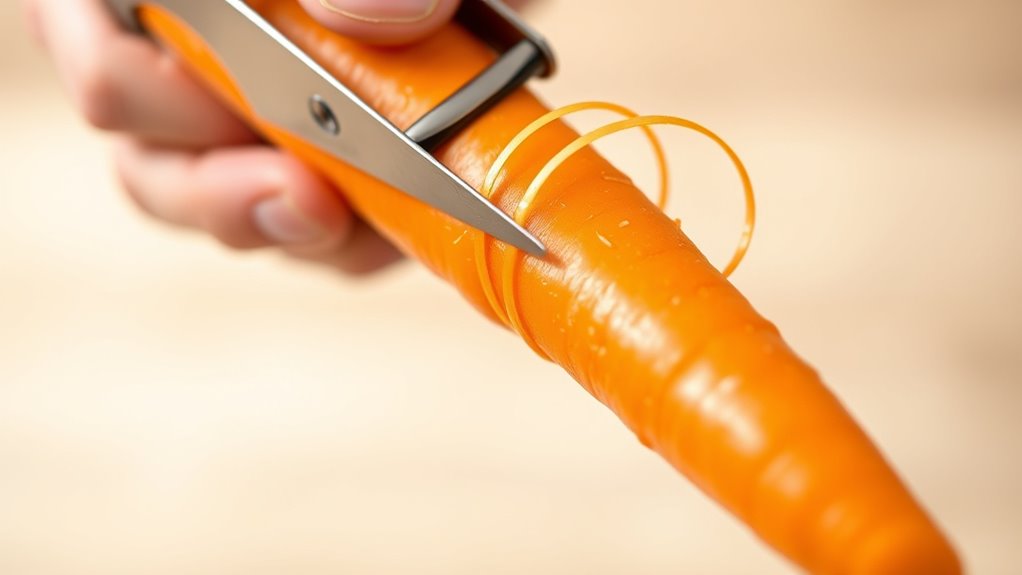
One common mistake is assuming that vegetable peelers should only be used with a single, one-directional motion. Many people peel in just one direction, which slows down the process and wastes effort. Instead, try using a controlled, gentle back-and-forth or multi-directional technique to speed things up. Another mistake is believing that loose or wobbly blades mean your vegetable peelers are defective; often, these are designed features that improve safety and efficiency. Applying excessive downward pressure also hampers your progress, increasing the risk of slips and cuts. Additionally, understanding the city dynamics of your peeling technique can help you adapt to different types of produce for better results. Incorporating attention during peeling can make the process more effective and enjoyable. Recognizing safety features can help prevent accidents during peeling. Being aware of the design features of your peeler can also help you select the best tool for various tasks. Paying attention to ergonomic design can further enhance comfort and control during use.
How Proper Technique Can Double Your Peeling Speed

By adopting a proper technique that involves moving your vegetable peeler in both directions without lifting it, you can double your peeling speed. This approach maintains constant contact with the vegetable’s surface, enabling a smooth, continuous motion that boosts efficiency. Using the peeler from top to bottom and back minimizes unnecessary pauses, saving time during large peeling tasks. Recognizing that many peelers have flexible, double-edged blades allows you to peel faster and safer when used correctly. To maximize your results:
- Apply even pressure to prevent slips and uneven peeling
- Use controlled, multi-directional strokes for better efficiency
- Maintain a consistent rhythm to reduce fatigue and speed up the process
Mastering this proper technique helps you peel more vegetables in less time, making your prep process quicker and less tiring.
The Surprising Benefits of Multi-Directional Peeling

Using your peeler in multiple directions can make peeling faster and more efficient, especially on long vegetables. It also reduces strain and offers a safer, more comfortable experience. Plus, compatible double-edged peelers are designed to maximize these benefits with minimal effort. Being aware of peeling techniques can further improve your results and safety during the process. Incorporating ergonomic tools can also help minimize fatigue and improve control during peeling tasks. Exploring proper tool maintenance can ensure your peeler remains sharp and effective over time. Additionally, understanding the weight of wind turbine blades can remind you of the importance of optimizing tools for efficiency and strength in various tasks. Recognizing the influence of family dynamics can also provide insights into personal habits and approaches to tasks like peeling.
Faster Peeling Technique
Switching to a multi-directional peeling technique can considerably speed up your vegetable prep. By moving the peeler both up and down without lifting it, you cut peeling time in half and increase efficiency. Using peelers with double-edged blades makes this process even smoother, allowing continuous peeling in both directions. This method produces thinner, more even peelings, especially on long vegetables like carrots and zucchini. It also offers better control, reducing the risk of cuts since the blade stays in contact with the vegetable. To maximize your peeling efficiency, consider these points:
- Employ a double-edged peeler for seamless, bidirectional peeling
- Focus on consistent, controlled motions for even peelings
- Practice on different vegetables to improve speed and accuracy
- Proper technique can help prevent clogs and residue buildup, ensuring your peeler remains effective over time
- Incorporating ergonomic design features in your peeler can further reduce fatigue and improve precision during extended use
- Being aware of peeler maintenance routines can extend the lifespan of your tool and maintain optimal performance
- Regular cleaning of the blade and handle can enhance peeler safety and keep it functioning smoothly
- Additionally, selecting a high-quality peeler with advanced blade technology can make your peeling experience even more efficient and effortless
Safer Vegetable Preparation
Adopting a multi-directional peeling technique not only speeds up your vegetable prep but also enhances safety. By leveraging the flexible, double-edged design of certain peelers, you can peel in both upward and downward motions, reducing slips and accidental cuts. This method keeps consistent contact with the vegetable’s surface, minimizing the risk of injury. Using this approach, you’ll find longer vegetables like carrots and zucchinis are easier and safer to peel. Recognizing the benefits of safe, multi-directional movement aligned with your peeler’s design boosts overall safety and efficiency. Additionally, understanding proper technique can significantly minimize cuts and improve your overall kitchen safety. Incorporating ergonomic peeler design features can further enhance comfort and control during peeling tasks. Developing a steady grip and controlled motion also helps prevent slips, especially when working with ergonomic features that promote better handling.
Compatible With Double-Edged Peelers
Double-edged peelers are specially designed to work seamlessly with multi-directional peeling, offering surprising benefits that can transform your vegetable prep. These innovative tools allow you to peel by pushing and pulling, reducing effort and increasing speed. The flexible, parallel blades produce thinner, more even peelings compared to traditional methods. Many double-edged vegetable peelers feature blades that wobble intentionally, adapting to irregular surfaces for superior results. When you use a double-edged peeler correctly, you minimize the risk of cuts by maintaining constant contact with the vegetable, making the process safer and more efficient.
- *Enhanced peeling efficiency with less effort*
- *Thinner, more uniform peelings*
- *Adaptability to irregular surfaces for better results*
Safety Tips for a Faster and Safer Peeling Experience

To guarantee a safer and faster peeling process, always check that your peeler has a double-edged blade before trying the dual-direction technique. Safety tips are essential to prevent accidents while speeding up your peeling. Use long, firm vegetables like carrots or zucchini for better control and reduced risk. Keep your fingers clear of the blade’s path and peel away from your body to avoid cuts. To stabilize the vegetable, consider using a fork or similar tool, which minimizes slipping. Practice controlled, deliberate movements, especially when pushing the blade toward yourself, to lessen safety hazards. By following these safety tips, you’ll peel more efficiently without sacrificing safety, making your peeling routine quicker and injury-free.
Recognizing the Right Peeler for Your Favorite Vegetables

Choosing the right vegetable peeler depends on how you plan to use it. The blade’s orientation and style can make peeling faster and safer, especially with different types of produce. Understanding these design features helps you pick the best tool for each vegetable and technique.
Blade Orientation Matters
Understanding your vegetable peeler’s blade orientation is key to selecting the right tool for your peeling tasks. The orientation determines how efficiently you can peel vegetables, especially during repetitive kitchen tasks. Peeler blades that run parallel to the handle support efficient peeling with a back-and-forth motion, ideal for long, smooth vegetables like carrots or zucchinis. Conversely, peelers with blades perpendicular to the handle are better suited for single-direction peeling and finer detail work. Recognizing the blade orientation helps you choose the most versatile vegetable peelers for your needs.
- Supports multi-directional peeling, reducing fatigue
- Facilitates smooth, continuous motion for larger vegetables
- Enhances efficiency and precision in your kitchen tasks
Choosing the Right Style
Selecting the right vegetable peeler depends on the types of vegetables you most often prepare. Different types of peelers are designed for specific tasks, so choosing the right one can make peeling easier and safer. For general peeling, straight-edged peelers are reliable, while parallel-blade peelers excel at creating thin, precise strips. Recognizing whether your peeler has a single or double-edged blade helps you decide if it supports advanced techniques like peeling in both directions. Peeler blades set at a 90-degree angle to the handle provide better control for firm vegetables like carrots and zucchini. For round or irregularly shaped produce, a flexible, wobbly blade adapts better to the surface. Matching your peeler style to your favorite vegetables ensures efficient, safe peeling with better results.
Frequently Asked Questions
How to Use a Vegetable Peeler Correctly?
To use a vegetable peeler correctly, you should move it back and forth along the vegetable’s surface without lifting it. Use controlled, deliberate strokes in both directions to peel efficiently, especially on long vegetables like carrots or zucchinis. Remember, the wobbliness of the blade is normal and helps with multi-directional peeling. With this technique, you’ll peel faster, safer, and with less waste, making your prep much easier.
How Often Should You Replace Vegetable Peeler?
You might think your vegetable peeler lasts forever, but experts recommend replacing it every 1 to 3 years. Dull blades, rust, or difficulty peeling are signs it’s time for a new one. Don’t worry—regular replacement keeps your peeler safe, effective, and easy to use. Proper maintenance prolongs its life, but prioritizing safety ensures you avoid injuries and enjoy smooth peeling every time.
Why Is It Important Not to Over Peel Vegetables?
You shouldn’t over peel vegetables because it strips away crucial nutrients and fiber just beneath the skin, which are essential for your health. Excessive peeling also wastes edible portions, increasing food costs and waste. By only removing a thin layer, you preserve antioxidants, vitamins, flavor, and texture. This way, you maximize the nutritional value and enjoy the full benefits of your vegetables without sacrificing their natural moisture and taste.
What Vegetable Peeler Do Chefs Use?
Imagine holding a tool that feels like an extension of your hand, designed for speed and precision. Chefs often choose Y-shaped peelers or julienne peelers, crafted from stainless steel for durability. These peelers offer ergonomic grips and versatile blades, making peeling effortless and safe. With their double-edged blades, you can peel quickly and efficiently, transforming simple vegetables into culinary art. This is the secret behind professional-grade peeling in your kitchen.
Conclusion
Next time you reach for your vegetable peeler, remember the hidden design and proper technique. It’s funny how a simple tool can transform your cooking—like discovering a secret shortcut when you least expect it. With a little adjustment, you’ll peel faster and safer, making meal prep feel almost effortless. Sometimes, all it takes is a small change to turn everyday chores into surprisingly enjoyable moments. Happy peeling!



